#first nations art
Text

Bill Reid (Haida/Canadian, 1920-1998), Xhuwaji - Haida Grizzly Bear, 1990. Colour silkscreen, 21 1/2 x 21 1/2 in.
544 notes
·
View notes
Text
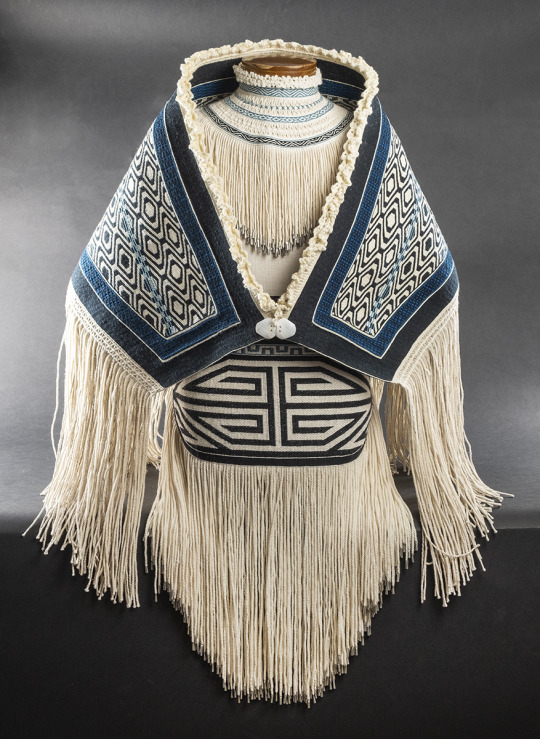
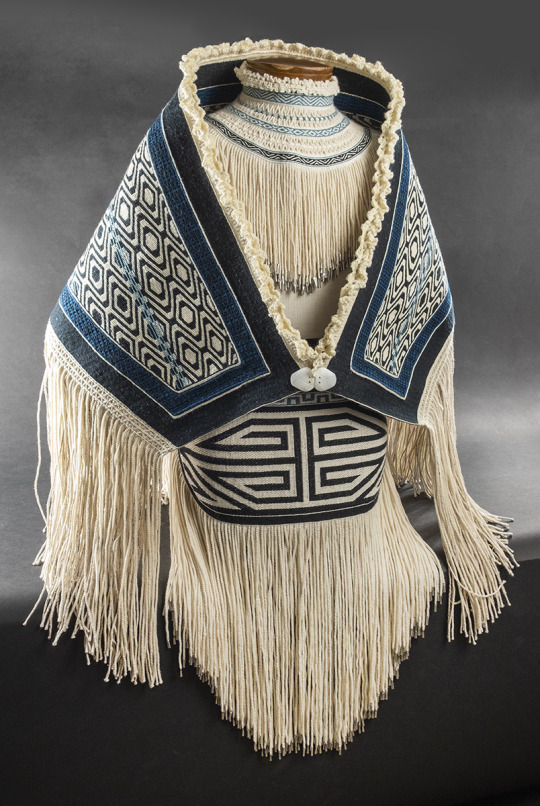
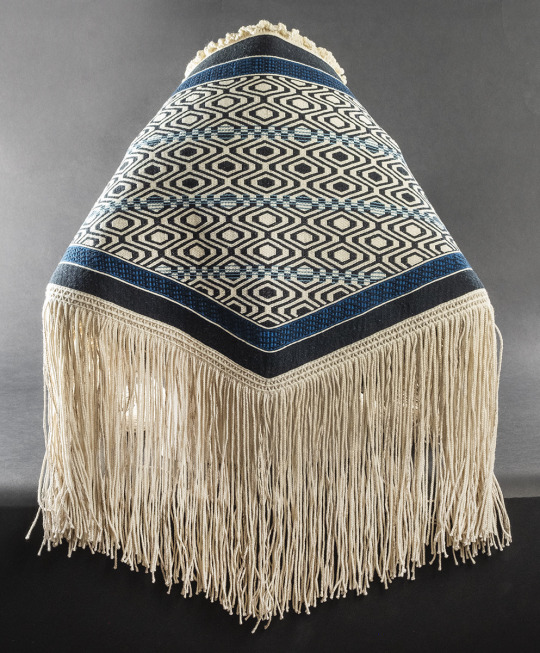
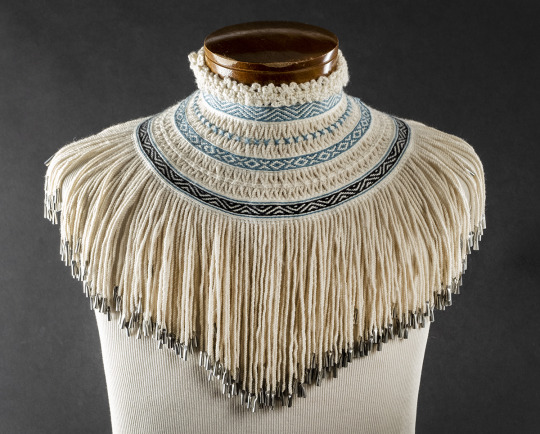
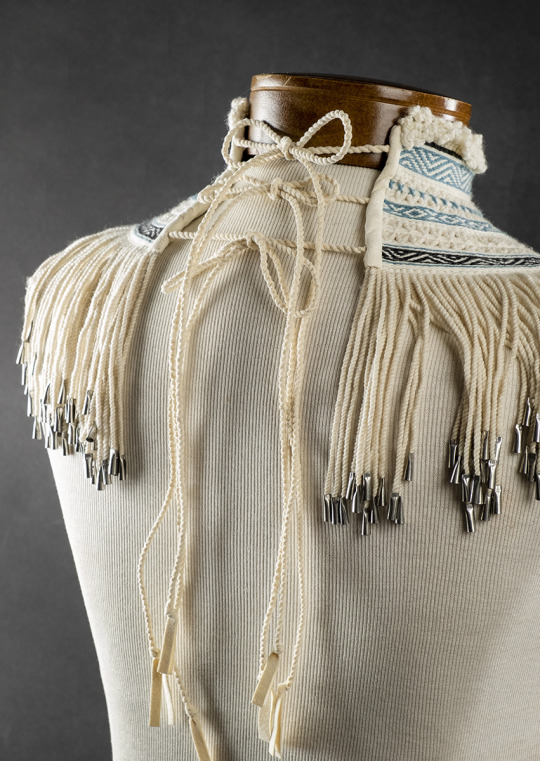




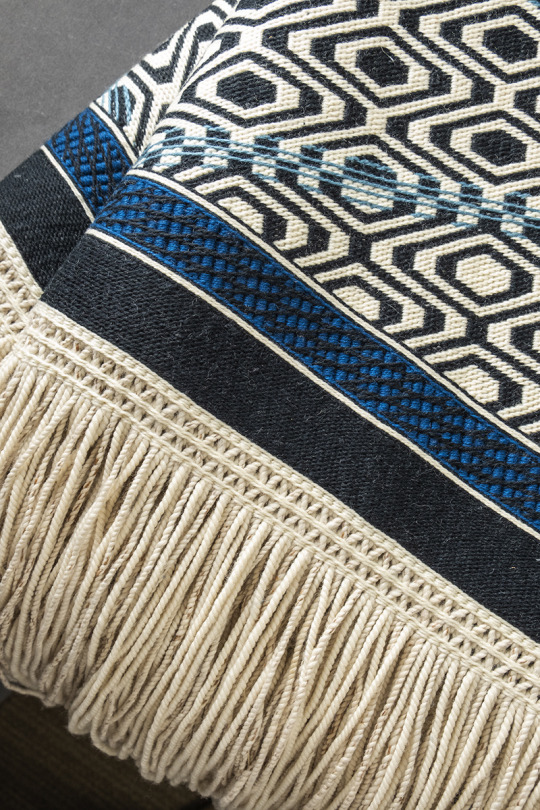
We Are The Ocean
Ursala Hudson (Tlingit/Filipino/German)
collar: merino wool, silk, steel cones, leather. ravenstail patterns, crochet, basketry twining technique. Woman as a Wave shawl: merino wool, silk, cedar bark. chilkat and ravenstail patterns, crochet, basketry twining technique. Tidal apron: merino wool, silk, leather, steel cones. chilkat and ravenstail patterns.
“We Are the Ocean is an ensemble comprised of a collar, apron (entitled Tidal), and shawl (entitled Woman as a Wave). The collar and bottom edge of the shawl are twined using a basketry technique to bring delicacy to the regalia, made specifically to emphasize the wearer’s feminine essence. In place of the sea otter fur that traditionally lines the top of Chilkat and Ravenstail weavings, the merino weft yarns were used to crochet the collar and shawl’s neck lines, bringing forward and incorporating a European craft practiced by both my maternal (Tlingit/Filipino) and paternal (German) grandmothers. The high neck of the collar gives tribute to the Western aesthetics that have forever influenced the Indigenous cultures of our lands; with grace, we embrace that which cannot be undone, and use our new form to be better. The apron’s pattern was studied and graphed from an old Tlingit cedar bark basket, and represents the tides of our lives, as our lessons continue to arise in a revolving cycle, yet made of new debris. The repetitive pattern of the shawl represents the infinite connectedness of our sisters, mothers, aunties, and daughters. Blue lines break up inverted rows, representing the “past,” “present,” and “future,” acknowledging these concepts as irrelevant constructs that fall away when we commune with the Divine. The entire ensemble is worn to evoke the innate spirit of the Woman as an ethereal deity, that resides within us all.”
#textiles#regalia#fiber art#weaving#ursala hudson#tlingit#filipino#indigenous art#native art#first nations art#ndn art
331 notes
·
View notes
Text


national cowboy & western heritage museum, oklahoma city, oklahoma.
1K notes
·
View notes
Text

Carl Ray
Moose
1977
#carl ray#moose#indigenous artist#indigenous art#first nations artist#first nations#first nations art#beautiful animals#nature#wildlife#nature aesthetic#modern art#art history#aesthetictumblr#tumblraesthetic#tumblrpic#tumblrpictures#tumblr art#tumblrstyle#artists on tumblr#aesthetic#tumblrposts
514 notes
·
View notes
Text
For #Woodensday:


#Seal figure by Melvin Olanna, 1968
Inupiat Eskimo, Shishmaref, Alaska, USA
Yellow cedar wood, L 32 x W 18.5 x H 20.5 cm
25/6106 Indian Arts & Crafts Board Collection, DOI, at Smithsonian NMAI
#animals in art#museum visit#20th century art#1960s#woodwork#effigy#sculpture#carving#seal#indigenous art#native american art#First Nations art#Melvin Olanna#Smithsonian NMAI
220 notes
·
View notes
Text

Desirai.art for NAIDOC Week 2024
#desirai art#blak artist#blak australia#indigenous art#aboriginal#torres strait islanders#NAIDOC#NAIDOC week#keep the fire burning#aboriginal artist#First Nations art
14 notes
·
View notes
Text

A Little Guy on a Yup'ik harpoon line, c1885-1930!
Little Guy rating: 10/10
Notes: ivory little guy! probably a seal!
#alittleguyaday#ivory carving#yup'ik#first nations#yupik#first nations art#sorry for the absence i was up a mountain#seal
14 notes
·
View notes
Text

got a couple pieces of singing tsuchinokou based on the folklore fatty (said lovingly) magical snake

wondering if I could find a way to rig them to sing with them maybe? we'll see it depends on life & health
#art#illustration#yokai#yokai oc#folklore#lamia#naga#イラスト#絵#ツチノコ#gay art#first nations art#native art
11 notes
·
View notes
Text


So between me being pissed at the increase of colonialism-related paraphernalia pre canada day and needing something to supplement my income I've decided to try out the world of online commerce.


Here is a 20% off discount code "tumblr20"
Please check out my store and share I've got clothing and stickers and more designs in the works that aren't canada specific. Eventually, I'll get my nature and fantasy formline stuff digitized and up.
Email subscribers will get a 30% off discount code sent out on Monday, June 19th.
31 notes
·
View notes
Text


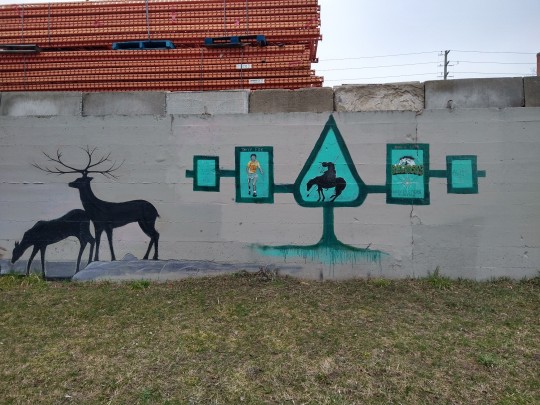
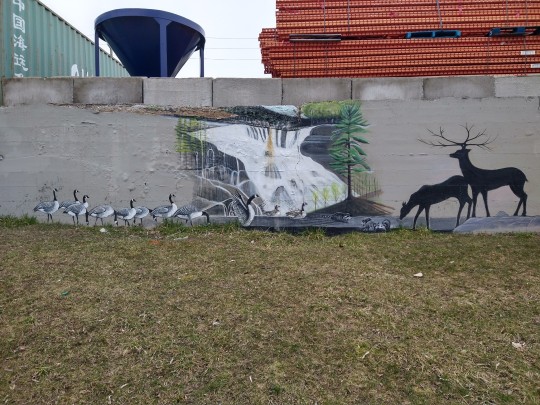
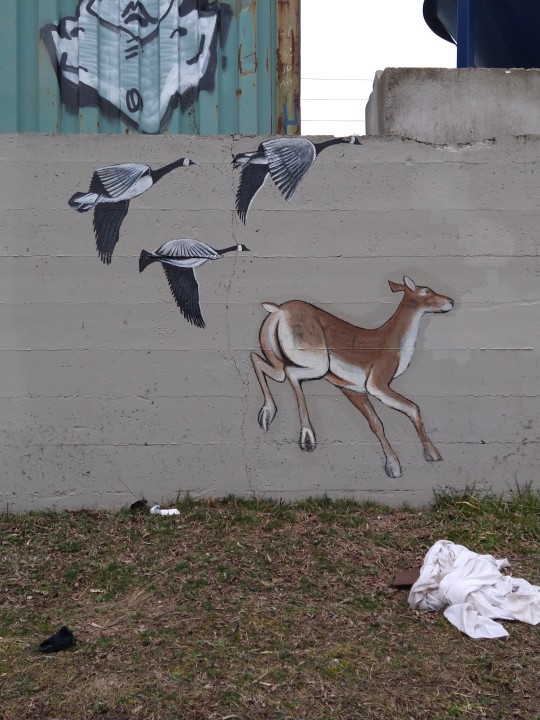


Some cool murals I saw down by the river today!
30 notes
·
View notes
Text
fur, money, adventure: mechanisms of colonialism and survivance
riel ✰ | march, 2023
“Of all the things on earth, the motherland is the most important
and sacred to us because we inherited it from our ancestors,”
- Louis Riel

Fig. 1, Wilson. I. Former Jean Caron Sr. House, Batoche Saskatchewan. Image courtesy of I. Wilson and Parks Canada
I am Red River Métis, descending maternally from historic Métis families by the names of Berthelet, Caron, Ste. Germain, Larivière, Dazè, Dubois, and Boudreau; we come from the Red River Settlement in Manitoba and Batoche, Saskatchewan. My Berthelet family members were employees of the North-West Company and community leaders in the town of Pointe à Grouette, now Ste. Agathe (St. Onge). My fifth great uncle Jean Caron Sr. fought in the Battle of Duck Lake of the North-West Resistance of 1885, with his sons and under the command of Gabriel Dumont, Jean Caron Sr’s house still stands in Batoche to this day (fig. 1). I introduce myself in this way, the traditional way of the Métis to situate myself on this land and contextualise my knowledge and experiences.
My practice serves to counter the settler-colonial understanding of Métis people and our history and establish us as a people who have been practising survivance for generations. With the help of aesthetics of survivance I oppose mechanisms of colonialism; aesthetics including the Hudson’s Bay Company’s bloody legacy, the monuments and public art installed throughout Calgary, the suburban cowboys that come out of hiding in their McMansions on the outskirts of the city, riding their steel steeds, raised trucks, to the summer Stampede. The aesthetics of survivance are “[...]more than survival, more than endurance, or mere response, [...] stories of survivance are the creases of sovereignty,” (Vizenor, 15). In her 2019 book The North-West is Our Mother by Jean Teillet, the author compares the birth of the Métis Nation to human birth; messy, bloody, painful. Our history is vastly complex and controversial in the eyes of the average Canadian settler today. It is a history that makes settlers uncomfortable, confused, sometimes defensive and angry in response to lack of knowledge and this ignorance is often no fault of their own. Canada has a carefully curated canon of history that we are all spoon-fed in school until given the chance to learn the other sides of this history, to think critically and hear stories of survivance.

Fig. 2, The Bay “Shopping is Good” advertisement, 2000. Courtesy of the HBC History Foundation
Countering aesthetics of survivance, The Hudson’s Company has developed their own aesthetics of colonialism. “Fur! Money! Adventure! That [is] what the Hudson’s Bay Company territory had to offer Englishmen and Canadians three hundred years ago,” (Sealy, 1). From the very beginning of the point blanket, with its iconic stripes on white wool, traded for a single beaver pelt to an advertisement from the year 2000 (fig. 2). An image of a nuclear family wearing matching white outfits in a clean white room. Everything accented with green, red, yellow, and indigo stripes, down to the scarf that the grandmother is knitting, referencing the histories of trade and handmade goods long abandoned by the HBC in favour of their modern department store model and multiple aesthetic rebrands throughout the years after the industrial revolution (Toneguzzi). The advertisement simply states, “Shopping is Good, Toronto”. Pro pelle cuttem, a pelt for a skin, a skin for a skin.

Fig. 3, Starr, Riel. Image of the original HBC logo, downtown Calgary. Image courtesy of the artist.
The HBC shield on a building in downtown Calgary (fig. 3) is a grim reminder of the bloody birth of this country, laughing in my face. As Billy Ray Belcourt puts it: “Canada is still in the business of gunning down NDNs. […] Despite the stories of progress and equality at the core of Canada’s national identity, a long tradition of brutality and negligence is what constitutes kinship for the nation of citizens sat atop the lands of older, more storied ones. […] What I can do is love as though it will rupture the singularity of Canadian cruelty.” (Belcourt, 5)
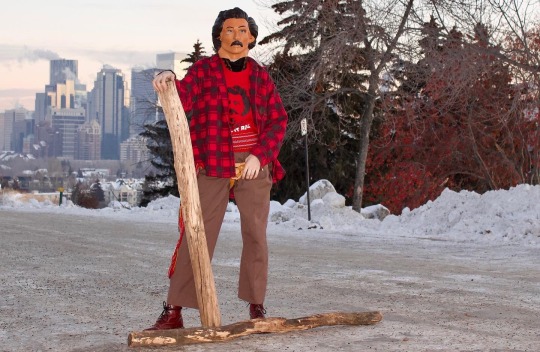
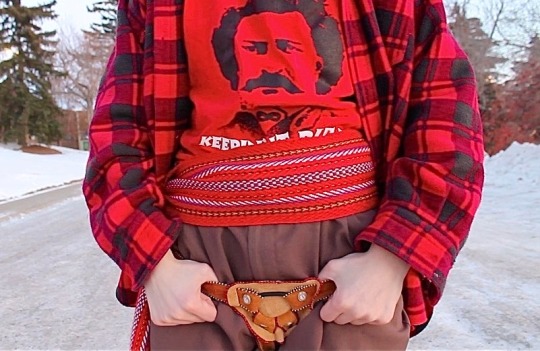
Fig. 4, 5, Starr, Riel. Otipemisiwak Fantasy Husband, 2022. Courtesy of the artist.
A Spectacle of Me for You: Otipemisiwak Fantasy (2022-present) is an ongoing body of work that explores the Métis identity through a modern and Indigiqueer lens, and through humour and the NDN belly laugh (Whitehead). The work consists of a series of photographs of myself wearing a costume I created using a combination of found and handmade garments. In the photographs from 2022 titled Otipemisiwak Fantasy Husband, (figs. 4 and 5) which have been printed in the form of stickers and two different postcard designs, the character Otipemisiwak Fantasy Husband (OFH), the masked trickster, poses with wood leftover from building a Red River cart in 2022. The aesthetics of survivance often incorporate embodying the skewed image that settlers have of the savage Indian, over exaggerating it so that that the joke remains in our own hands, and we can laugh at the ignorant moniyaw. In these photographs OFH is wearing a red and black lumberjack flannel over a red shirt with a black graphic of Louis Riel’s Face and white text that reads “Keeping’ it Riel,”. Around his waist is a ceinture fléchée, and a beaded leather strap on harness worn over brown dress pants. On his head is a latex mask of Louis Riel, his skin is placid and his features cartoonish, in the style of the masks of American presidents used in the 1991 film Point Break (directed by Katherine Bigelow) (fig. 6).

Fig. 6, Patrick Swayze, James Le Gros, Bojesse Christopher, and John Philbin in Point Break (1991), dir. Katheryn Bigelow. Image courtesy of Twentieth-Century Fox.
This work explores the aestheticization of colonialism through these political figures and latex masks which can be attributed to the abstraction of the real person from their caricature in history and in the cultural zeitgeist. One postcard design contains a full body shot of the character in a comically dominant pose with a log positioned suggestively between his legs, standing in for the strap on harness’s missing toy. The second design is a close-up shot of the character’s pelvis, the strap on harness visible with his thumbs hooked casually on the straps.
Referencing other Indigenous artistic personas such as Adrian Stimson’s “Buffalo Boy” and Lori Blondeau’s “Belle Sauvage” (fig. 7), my artwork including OFH satirises the settler-colonial understandings of Louis Riel as a violent traitor to the government by pointing to the ways his story has grown into a mythology of sorts in the eyes of Canadians in a similar manner to other related figures like the former presidents represented in Point Break.

Fig. 7, Stimson, Adrian; Blondeau, Lori. Belle and Boy’s Savage Buffalo Happy Hour. Image courtesy of Adrian Stimson and Lori Blondeau.
Like Stimson’s Buffalo Boy, my character represents an exaggerated Métis identity in order to “[…] camp up colonialism, sexuality, and authenticity,” embodying the trickster archetype like Buffalo Boy in the words of Stimson, “he’s campy, ridiculous, and absurd, but he is also a storyteller, who exposes cultural and societal truths,” (Rice, Taunton, Stimson). OFH mimics the over-sexualized settler-colonial perception of Indigenous masculinity, sexuality, and queerness and is an exploration of the ways in which my identity is tokenized: sexually, spiritually, academically, and culturally.
A Spectacle of Me for You: Otipemisiwak Fantasy is a way of participating in the phenomenon within contemporary Métis art of Louis Riel related kitsch objects that flood markets across the Métis homeland. Alongside and juxtaposing red and white Canadian kitsch that litters tourists' traps and contemporary art galleries across this land, appears the stoic face Louis Riel, gazing out at the country that has developed since his murder in 1885. As Marilyn Dumont puts it: “Riel is dead, but he just keeps coming back,” (70) Contemporary artists like Jessie Ray Short embody Louis Riel by taking on his likeness as a costume. The short film Wake up! (2015) (fig. 8) is a queering of this popular trend.

Fig. 8, Short, Jessie Ray, still from Wake Up!, 2015, video with sound, 5:58 min. Courtesy of the Artist, via Mount Pleasant Community Art Screen
The artist, transforms herself into Louis Riel by applying facial hair, a wig, and clothing to mimic the most famous portrait of Riel in a drag-esque performance. The work asks, “How do you explain a culture in small talk?” and is an example of the “re-examining the cultural significance of Louis Riel [that] allows us to consider the ways in which we can question representation while still respecting the importance this history holds.” (Junker)
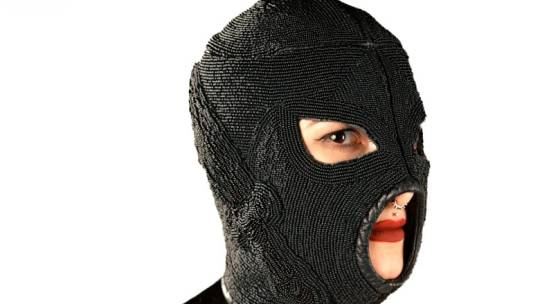

Fig. 9 (left), Danger, Dayna. Digital print of Adrienne Dagger, wearing one of Dayna Danger's fetish mask. Image courtesy of the artist and CBC news.
Fig. 10 (right), Danger, Dayna. Big’Uns: Adrienne, 2017. Courtesy of the artist’s website.
The beaded strap-on worn over the pants and the explicit nature of the posing is in reference to Dayna Danger’s Big’Uns (2017) (fig. 10) series, as well as their series of beaded fetish masks for their emphasis on material and process (fig. 9). The result is what Danger refers to as “the most Native BDSM thing ever,” to wrap yourself in beads. Like Danger’s beaded mask project, the Otipemisiwak Fantasy Husband persona came about partly out of a joke, the desire to make something humorous and sexy. Being queered by my Indigeneity, my sexuality, and gender, I consider Sara Ahmed’s words from the introduction of her book Queer Phenomenology: Orientations, Objects, Others,
“A queer phenomenology, perhaps, might start by redirecting our attention toward different objects, those that are “less proximate” or even those that deviate or are deviant. And yet, I would not say that a queer phenomenology would simply be a matter of generating queer objects,”
The emphasis on the strap-on harness points to a specific queer object with cultural associations within the concept of queer phenomenology and orientations. It functions not only as a deviant object or a queer object but also an Indigiqueer “orientation device,” (Ahmed, 3).
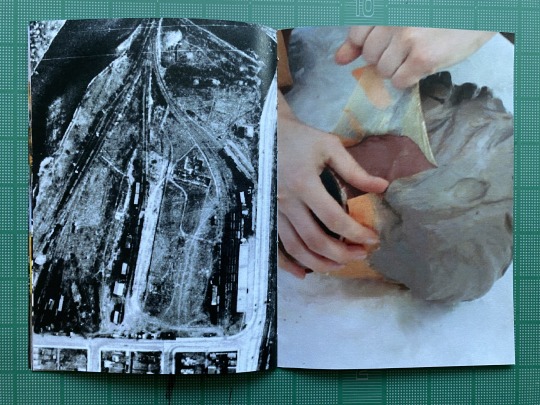
Fig. 11, Starr, Riel. Spread from Reading Marilyn Dumont to A Railway Berm, 2023. Image courtesy of the artist.
The most recent work in A Spectacle of Me for You: Otipemisiwak Fantasy is a performance titled Reading Marilyn Dumont to A Railway Berm (2023) in which OFH, sporting a new fringed leather jacket and matching tan suede Manitobah Mukluks reads poetry by Métis poet, author, and academic Marilyn Dumont to the dismantled railway that once entered the former Fort Calgary. The title of the poem is A Letter to John A. MacDonald and the author directly addresses the first prime minister and informs him of his failed railroad project. In addition to the Louis Riel mask, I had also begun the process of making a mask in the image of John A. MacDonald but had not found a use for it until reading the poem by Dumont. The performance is documented in the form of a hand-bound zine using imitation sinew, with photo documentation of the performance of reading to the railroad and John A. as well as the action of “scalping” the John A. mask to remove it from the base. This is contrasted with documentation of the site using both historical and modern images taken during the performance and sourced from the museum of Fort Calgary’s website (fig. 11).

Fig. 12, Starr, Riel. Prairie Vessel, 2022. Image courtesy of the artist.
Prairie Vessel (2022) (fig. 12) is an exploration of Métis aesthetics of survivance, specifically the Red River Cart and its material and physical qualities, as well as its history and symbolism in our culture. The Red River Cart is represented in the contemporary Métis Nation of Alberta and Manitoba Métis Federation logos, the cart being revered as an important symbol of survivance to our people. Historically the carts were built without the use of standardised measurement or plans, however there were two defining design features common to all Red River carts; their two wheels and lack of any metal joinery, only using wood and rawhide in their construction. The research for this piece included scouring online databases like the Louis Riel Institute and the Gabriel Dumont Institute in order to find any sort of construction plans for the carts. George Fayant is one of the few Métis makers with this skill, and has been building them for over two decades, since 1998 (Patterson). Prairie Vessel (2022) is a study of Métis material culture out of the need to preserve a lesser-known art form, and to practise survivance both personally and for my people so that I may keep knowledge and ways of making beyond alive, to keep them thriving in the spirits of my ancestors and all living Métis.
I am just one Halfbreed, but I am still Halfbreed. My ancestors' spiritual and genetic material makes up my personhood and part of that personhood is in all Métis. I do not yet know who I am to my people, but I carry an important name and an old spirit. I would like to be a trickster, “lotta raven in that one,” they’ll say (Maracle, 19). I would like to be like old James Bird Jr., trickster, trader, smart as a whip, a deadly sense of humour, and mean to missionaries. Wiisakayachack, Nanabush, Bluejay, Raven, Coyote, Li P’tchi Mond, Chi Jean, James Bird Jr., I long to be a chakapish.
Works Cited
Ahmed, Sara. Queer Phenomenology: Orientations, Objects, Others. Duke University Press, 2006.
Barkwell, Lawrence. Métis Mythology and Folklore: Mythological figures. Métis Museum, Louis Riel Institute.
Belcourt, Billy-Ray, et al. A History of My Brief Body. Two Dollar Radio, 2020.
Bigelow, Katheryn. Point Break. Twentieth Century Fox, 1991.
Danger, Dayna. “The most Native BDSM thing ever”: Dayna Danger’s Fetish Masks Challenge Indigenous Sexuality Taboos. CBC Radio, 2018.
Danger, Dayna. Big’Uns: Adrienne. The Resilience Project, 2017.
Dumont, Marilyn. A Really Good Brown Girl. Brick Books, 1996.
The Hudson’s Bay Company History Foundation. The Bay, “Shopping is Good” advertisement, 2000.
Junker, Jocelyn. Capture Photo Festival: Jessie Ray Short’s Wake Up! (2015), 2022.
Maracle, Lee. A Really Good Brown Girl: Introduction. Brick Books, 2019.
Patterson, Dayne. Red River cart unveiled at U of S celebrates Métis presence on campus. CBC News, 2022.
Rice, Ryan, and Carla Taunton. “Buffalo Boy: Then and Now.” Fuse Magazine, vol. 32, no. 2, 2009, pp. 18–25.
Sealey, D. Bruce. Stories of the Métis /. Manitoba Metis Federation Press, pg. 1, 1973.
Short, Jessie Ray. Wake Up!, 2015. Mount Pleasant Community Art Screen, 2022.
Stimson, Adrian, “Buffalo Boy: Then and Now.” Fuse Magazine, vol. 32, no. 2, 2009, pp. 18-25.
St-Onge, Nicole J.M. “The Dissolution of a Métis Community: Pointe à Grouette, 1860–1885.” Studies in Political Economy 18.1 (1985): 149–172. Web.
Toneguzzi, Mario. Hudson’s Bay Co. Launches Strategic Rebranding Amid Privatization. Retail Insider, 2020.
Vizenor, Gerald. Fugitive Poems: Native American Indian Scenes of Absence and Presence. Lincoln, Nebraska: First Bison Book 2000, p.15.
Whitehead, Joshua. Full Metal Indigiqueer: Poems. Talon Books, 2017.
Wilson, I. Former Jean Caron Sr. House, Parks Canada, 2002.
#this is my grad paper!!!!!#riel text#undergrad#art writing#contemporary art#indigenous#métis#michif#my work#writing#academia#academic writing#my practice#indigenous art#first nations art#please read or else!!!
27 notes
·
View notes
Text

Spaced Invaders - 2014
Sonny Assu (Ligwilda'xw Kwakwaka'wakw)
digital intervention on an Emily Carr painting (Heina, 1928)
#sonny assu#kwakwaka’waka#Ligwilda'xw Kwakwaka'wakw#indigenous art#native art#first nations art#ndn art#digital art#emily carr
223 notes
·
View notes
Text
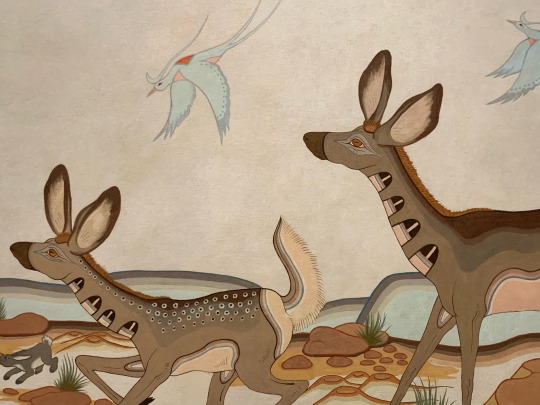
art details. national cowboy & western heritage museum, oklahoma city, oklahoma.
39 notes
·
View notes
Text

Carl Ray
Northern Lights
1974
#carl ray#landscape#landscape painting#indigenous art#indigenous artist#indigenous#first nations art#first nations artist#first nations#nature#nature aesthetic#modern art#art history#aesthetictumblr#tumblraesthetic#tumblrpic#tumblrpictures#tumblr art#tumblrstyle#artists on tumblr#aesthetic#tumblrposts#sea view
58 notes
·
View notes
Text
For #Woodensday:

Kwakwaka'wakw artist
Baleen Whale Mask, 19th century
Alert Bay, Cormorant Island, British Columbia, Canada
Cedarwood, pigment, hide, cotton cord, metal nails
From Brooklyn Museum’s “Climate in Crisis: Environmental Change in the Indigenous Americas” exhibition
#animals in art#whale#mask#Brooklyn Museum#museum visit#exhibition#Woodensday#woodwork#19th century art#First Nations art#Indigenous art#Kwakwaka'wakw#Canadian art
379 notes
·
View notes
Text

Emily Kame Kngwarreye, Ntange Dreaming, 1989
20 notes
·
View notes